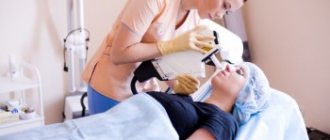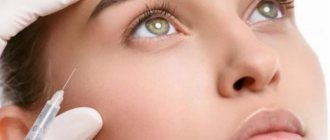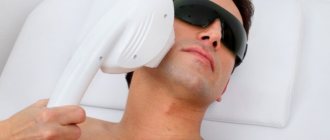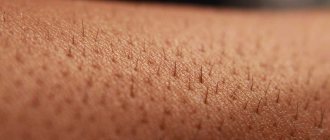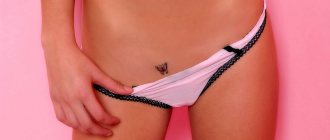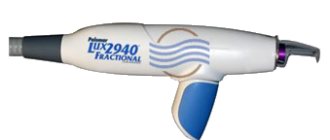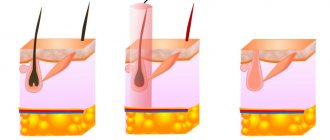Features of facial photoepilation
Facial photoepilation is a common procedure, the principle of which is based on the formation of a focused beam of light by a special device. The light beam affects the hair root and destroys the hair follicle. Accordingly, the hair will no longer be able to grow in this place. The light beam is absorbed by the melanin contained in the hair, sent to its root, converted into heat, which has a destructive effect.
Among the advantages of the procedure is its high speed - depending on the treatment area, the procedure takes from 5 to 20 minutes, the “antennae” area is cleared of excess hair in 15 seconds. The manipulation is effective on all shades of hair and skin (with the exception of transparent, gray hairs, completely devoid of melanin). It is used on all areas - from legs to face, deep bikini; after treatment, processes of active regeneration, production of collagen, elastin, and rejuvenation are launched in the epidermis. The technique is as gentle as possible - the skin is not damaged, there are no burns.
The procedure was first used in the late 1990s. It became widespread a few years later, when its safety was confirmed by official medical research.
For which areas is photoepilation suitable and most often used?
The face and chin are subjected to this procedure, but only if the hairs in these areas are approximately the same length and thickness.
But it is not advisable to do photoepilation around the eyes, because light can have a negative effect on vision. For the bikini area, photoepilation is preferable because it can directly affect hairs in a certain area without removing them one by one. In addition, the procedure is less painful than, say, electrolysis; many can endure it without anesthesia. However, photoepilation is not always suitable for solving these problems! It is only indicated if the hair is medium or dark in color. In addition, photoepilation gives a prolonged, but not permanent result; after some time the procedure will have to be repeated.
The armpits are an ideal area for photoepilation. The hair there is usually darker than on other parts of the body, and the skin is relatively light because it is not normally exposed to sunlight. The vast majority of women prefer to get rid of hair in the armpit area one way or another - this is dictated by both fashion requirements and personal hygiene considerations. But there is one nuance that the client must be informed about in advance: photoepilation in the armpit area can be more painful than in other areas, because due to the curves of the body it is not possible to apply the device very tightly to the skin.
Arms and legs are attractive areas for photoepilation, since the procedure is not invasive, is carried out immediately on a fairly large area and takes less time than electrolysis, during which each hair is treated separately. But the same restrictions remain: light skin, fairly dark hair, and do not forget that hair is not removed forever.
Preparation
In order for the procedure to be effective, efficient, and not cause harm, it is necessary to carefully prepare for it. To do this, follow a number of rules:
- Consult a dermatologist about the condition of your skin and the admissibility of treatment in this way;
- Consult with the specialist with whom you are directly going to perform the procedure - about the effectiveness of the manipulation, the estimated required number of procedures, the advisability of choosing this particular technique in a particular case;
- Two weeks before the procedure, you should avoid visiting solariums and exposing your skin to direct sunlight, use sunscreen with a filter of at least SPF 30 whenever going outside during daylight hours, wear hats with wide brims and visors;
- Do not use self-tanning or other skin tinting products;
- Refuse to remove hair on the treated area a month before the manipulation - during this period they will grow to a sufficient length to completely absorb and conduct a beam of light to the root of the hair;
- If possible, stop taking medications (especially antibiotics, antipsychotics, antidepressants, tranquilizers) at least a week before the procedure (consult your doctor).
There may be other contraindications - this must be taken into account when visiting a dermatologist on the eve of the photoepilation procedure.
How is the procedure done?
The traditional photoepilation procedure includes the following steps:
- The patient comes into the office, lies down on the couch;
- The facial skin in the treated area is cleansed of dirt/makeup;
- A composition is applied to the area that can slightly numb the pain, have an antiseptic effect, protect the skin from burns and light damage during the procedure - usually this is a water-based hypoallergenic gel;
- The patient's (and the technician's) eyes are covered with special glasses to avoid burns;
- The technician turns on the device, directing its working surface to the problem area, waiting for the flash;
- Flashes occur every 5 seconds, after each of them the device moves - the adjacent area is processed;
- This method treats the entire problem area;
- The protective gel is removed from the skin;
- A soothing composition is applied to it, accelerating regeneration and recovery.
Depending on the area being treated, the duration of the procedure varies, but is always short - photoepilation of the eyebrows, mustache area takes 5-10 minutes, chin area, sideburns - 10-15 minutes.
Most problematic areas
Most of the girls' faces are covered with inconspicuous fluff, which does not require removal. The areas near the upper and lower lips are mainly subjected to photoepilation.
The most problematic areas for girls are:
- area above the upper lip;
- chin;
- brows.
Women with high levels of hormones in the body experience active growth of vegetation in other areas of the face.
Before performing photoepilation near the lips, it is necessary to exclude the presence of any contraindications to the procedure. This fact is determined by a dermatologist.
The procedure time depends on the area where hair is being removed. On average, it takes 5-10 minutes to treat the upper lip and eyebrows. Chin photoepilation takes up to 15 minutes.
Eye precautions
During the procedure, the device generates powerful beams of high-intensity light aimed at the treated areas. Regardless of which specific area is being treated, there is a possibility of retinal damage and burns. But the closer the treatment area is to the eyes, the higher this probability.
For protection purposes, simple sunglasses are not suitable, since they still allow some of the rays to pass through. The patient puts on special plastic devices, the edges of which fit tightly to the skin and are completely opaque. The master puts on translucent safety glasses, through which visibility is sufficient to perform the procedure.
Advantages:
- long lasting cosmetic effect (about 5-7 years),
- painlessness,
- safety (radiation has no harmful effects on the body),
- no ingrown hairs,
- quick procedure (one session takes no more than 5 minutes).
Thus, after completing a full course of photoepilation of the upper lip, you will get rid of the problem of unwanted hair for a long time. Thanks to this method, the skin becomes smooth and clean without irritation or pain. The reappearance of vegetation may be due to hormonal imbalances; in this case, consultation with an endocrinologist and the necessary treatment are required.
Facial aesthetics
Remove pimples or acne
- Get rid of acne
- Get rid of enlarged pores
- Remove scars and scars
- Remove unwanted hair
- Moisturize the skin
- Improve complexion
Hair health
- Diagnostics of hair and scalp
Skin treatment
- Skin diagnostics
Body
- Reduce volumes
Face modeling
- Change the shape and volume of lips
Hands
- Get rid of unwanted hair
Facial rejuvenation
- Tighten the oval of the face
Intimate area
- Vaginal rejuvenation
Feet
- Get rid of sweating
Is it possible to remove eyebrows with a photoepilator?
Any area can be treated with a photoepilator, as this is an accurate, gentle method. Although there is a greater chance of eye damage in the process, safety glasses can help prevent retinal burns. They are small in size and do not cover the eyebrow area at all.
The accuracy of the light beam is not so great that it can be used to perform high-quality eyebrow correction. But the accuracy of the procedure is sufficient for complete removal of eyebrows (with an alternative style or the intention to later apply them with microblading), and cleaning of excess hair from the bridge of the nose (if fused).
Facial skin care after the procedure
During the procedure, minor damage to the skin and burns from beams of light occur. In order to avoid serious consequences of this phenomenon, it is necessary to carefully care for the skin after the intervention, follow the following rules:
- If swelling, redness, and mild pain in the treatment area do not disappear even a couple of hours after the procedure, cool the affected area with a compress;
- In case of severe discomfort, it is permissible to take non-steroidal anti-inflammatory drugs as needed, but not more than 3 tablets per day (Ibuprofen, Nurofen);
- Healing agents - Panthenol, Bepanten - are applied twice a day for a week (this is not always necessary, it is discussed individually with the specialist);
- For a week, do not use cosmetics on the treated area, especially those containing alcohol;
- For the same period, refrain from visiting swimming pools, saunas, baths, natural reservoirs, and do not steam in the bathroom;
- For two weeks, protect your face from direct sunlight by wearing hats with visors/wide brims, and use sunscreen with a filter of less than SPF 30 from the second week after the procedure.
Depending on the characteristics of the patient’s skin and the location of the procedure, there may be other restrictions and recommendations. This issue is resolved with the master on an individual basis.
Photo gallery of faces before and after hair removal
The first effect after the procedure is noticeable immediately. Getting rid of hair lasts for six months or a little less. After this, the sleeping follicles “wake up” - hairs begin to grow out of them, thinner, lighter, and more brittle. Destroyed follicles are not restored.
To obtain a long lasting effect, at least 6-8 procedures will be required. They can be carried out, depending on the type of skin, hair, and treatment area, at intervals of two to six weeks. The stability of the effect depends on the state of human health, the amount of male sex hormones, genetic predisposition, and the characteristics of skin and hair regeneration.
What hair removal looks like on the face can be seen in the photo in the material.
Mustache photoepilation for women
Secondary facial hair occurs in every second woman. It can be in both brunettes and blondes. On dark skin, such a flaw is much more noticeable and causes more trouble. The appearance of facial hair in women is caused by:
- heredity;
- national characteristics of anthropology;
- hormonal disbalance.
Photoepilation of the mustache will finally help solve this problem.
The price of the procedure is affordable, so anyone who experiences this problem can use it.
